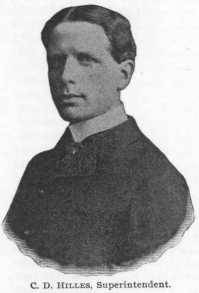
C. D. HILLES, Superintendent
(Click on photo for enlarged version)
Copyright © 2005-2017
Ohio American Local Hisotry Network
No copyright is claimed on non-original or licensed material.
Return to Early Institutions
Go to Main Page
|
THE Boys' Industrial School is Ohio's reformatory of juvenile male offenders. It is six miles south of Lancaster, Fairfield county on the Hocking Hills. The state owns 1,210 acres of land in this picturesque region, and the boys are taught agriculture and horticulture to the extent of producing all the vegetables and fruit that the institution consumes. The institution is organized on the cottage or segregate system, is not surrounded by walls and is entirely free from bolts, bars or other suggestions of restraint. It was the first penal institution in America to make the "open system" experiment, and so successfully was it operated that twenty-eight states have used the Lancaster school as a model. There are not 840 boys confined in the school for offenses against the statutes. These boys range in age from 8 to 18 years and are serving indeterminate sentences. When received at the School they are charged with demerits corresponding in number to the nature of the crime. These demerits must be cancelled by exemplary deportment in school and shop, before release. When released, a boy is on parole and can be returned for misconduct at any time before he reaches his majority. The boys are required to attend school one-half of each day, and are in shop or on the farm the other half. There are many trades schools where the boys are taught useful mechanical knowledge and at the same time contribute to the comfort and support of their fellows. Chief among these trades are blacksmithing, floriculture, tailoring, baking, printing, carpentering, telegraphy, stenography, brickmaking, shoe-making, dairying, cooking, etc. They also operated the steam, cold storage and electric plants, the barn, laundry and poultry plant. A boy band of forty-two pieces is maintained and the school is organized into a regiment of three battalions, under instructions of a competent military man. Music and physical culture are also features of the training.
|
Return to Early Institutions
Go to Main Page